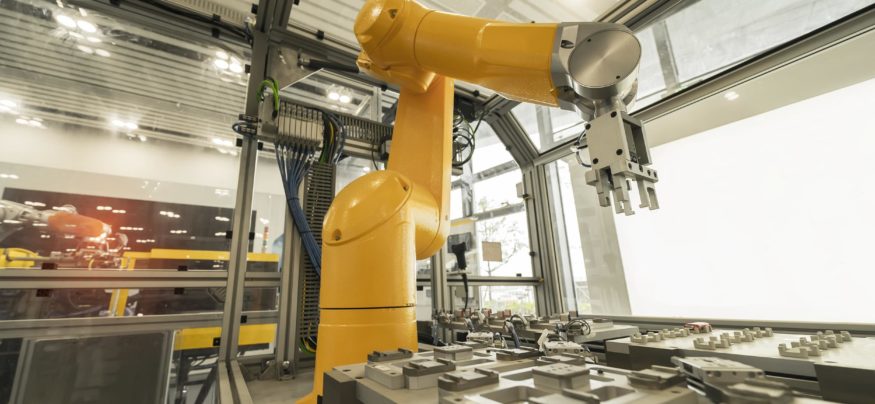Despite the grim numbers, things are trending up for US manufacturers: 11.5 million manufacturing jobs in 2010 grew into nearly 12,400,000 by December 2017, according to the Bureau of Labor Statistics. The Pew Research Center reports that 81 percent of Americans know that the total number of manufacturing jobs is less than it was three decades ago, but only 35 percent know that the US now manufactures more with fewer workers. Manufacturing output for the first quarter of 2017 was more than 80 percent above the level of 30 years ago, after adjusting for inflation. Why? New technologies.
Technology Enables Efficient Manufacturing
Technology has been the primary reason for manufacturers’ ability to produce more output with fewer workers. Automation, machine-to-machine data exchange, robotics, mobile data access via the ubiquitous cloud, Manufacturing 4.0: all contribute to what has become an efficient industry that is far more productive than three decades ago.
However, the enlightened manufacturer understands it is not merely technology which fuels the enviable record of efficient production. It is only when the proper technology is deployed along with well-designed business processes that an enterprise can function at its optimal capacity and generate the return on investment that technology solutions promise. Enterprise technology such as an ERP solution seldom produces the desired results unless business process are reviewed and redesigned at the same time.
First Things First: The Current State
The first step is to define your business performance measurements. We look to The Balanced Scorecard by Kaplan and Norton to determine next steps. It recommends creating a scorecard to track the metrics of four categories:
- Customer measures
- Financial measures
- Internal measures
- Innovation measures
This helps establish a baseline from which your enterprise can track results from its current state. Determining the desired future state defines what success looks like and whether the cost is worth the investment.
Assessing Business Maturity
We assess the capabilities and maturity of the business and its processes with the use of the Capability Maturity Model.
Companies contemplating an investment in new technology solutions typically aspire to achieve Level 5 results but aren’t there yet.
Companies in the underperforming levels often attempt to be everything to all customers. This can cause the business to be over-extended and ineffective at attaining any of their goals.
With the existing technology platform assessment and a review of the top-level strategy complete, the team now has the vision to attain the appropriate strategic tools to complement the opportunities and performance metrics they have previously developed.
Now the real work of maximizing the ERP investment begins.
Allocating Tasks
The implementation team has likely identified dozens, and even hundreds, of opportunities to improve work processes, and they are all worthwhile at some level. But no organization can effectively work on all of them simultaneously. To further complicate things, each team member, as well as the support and production personnel, has a day job in addition to project responsibilities.
Managing project resources can become complicated quickly. So early on, limit the number of projects that are active at any given time for any individual. A key to the success of a business transformation will depend on completing active projects as fast as possible. To accomplish this, break down projects into the tasks required to complete the project. Tasks should never take longer than one to two weeks. This provides a way to keep the responsible task leader and team focused.
If task completion dates begin to slip, it’s a sign that team members are overloaded and an assessment of the number of active tasks is in order. In addition to actively managing and participating in the active project, members of the Transformation Lead team must be the thought leaders for your business. It’s critical that team members are well-versed in the nuance and skills of Six Sigma, Lean Manufacturing, and managing cultural change in an organization.
The Future State
Many manufacturing companies set goals based on historical performance. It’s easy to look at last year’s performance and set a goal to increase revenue by 10 percent or reduce costs by eight percent. This is better than standing still but hardly world class.
World class results won’t be achieved merely by upgrading your current ERP system or purchasing a new solution. There has to be a concurrent emphasis on evaluating current business processes and introducing more efficient and less wasteful process to truly transform the business.
Establishing a stretch goal that represents a 30-50 percent improvement over the baseline is only accomplished when the team understands it can no longer rely on legacy work processes. In order to achieve a stretch goal everyone must utilize the tools at hand and be prepared to alter business processes in new and innovative ways.
Key Takeaway
In the end, it’s not only about technology. Evaluating the right technology solution for business process improvement and revising work processes can result in a business that is significantly transformed and operating at optimal efficiency.
When the desired future state has been realized the pain of changing workplace behavior and learning new skills will be forgotten.
Jeff Carr is the founder of Ultra Consultants.
Copyright Advantage Business Media May 14, 2018
This article was from Manufacturing.net and was legally licensed through the NewsCred publisher network. Please direct all licensing questions to legal@newscred.com.
download this free white paper.
![]()








